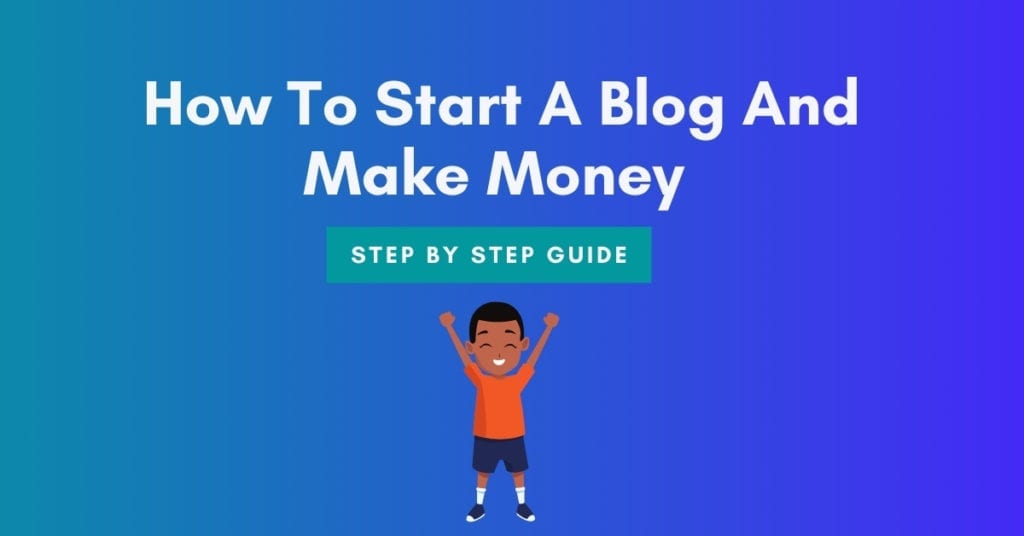
Learning how to start a blog isn’t hard. Staying committed is hard. Commitment to blogging is the first step to making money as a blogger.
Before I go into each step on how to start a successful blog, If you already have a topic in mind, register a domain name. Every website online needs a domain name.
The goal of this step-by-step guide is to both inform and inspire you to take action to start a blog today. Taking action is the key to achieving your goals.
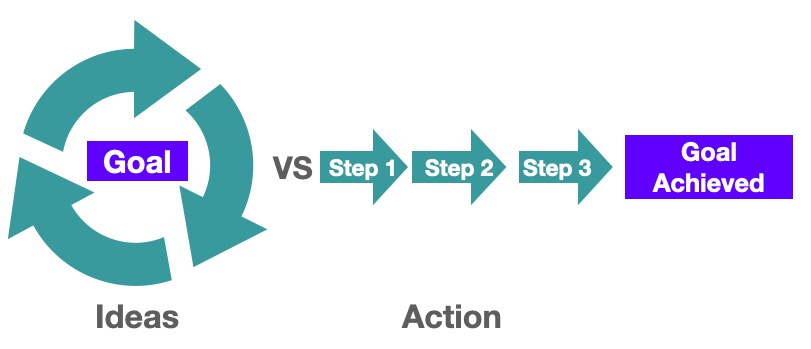
Ideas are great; taking action on ideas are greater. So without further ado, let’s get started.
- Step 1.) Select a topic for your blog
- Step 2.) Choose a blogging platform
- Step 3.) Decide which web hosting provider to use
- Step 4.) Pick a memorable domain name
- Step 5.) Choose a blog theme
- Step 6.) Write great blog content
- Step 7.) Implement SEO
- Step 8.) Install Google Analytics
- Step 9.) Promote your content across the web
- Step 10.) Build retention offering value to readers
- How to start a Blog FAQ’s
Step 1.) Select a topic for your blog
Selecting a blog topic is the hardest part of how to become a blogger. Ask yourself one question at this point.
Why do you want to start a blog?
Once you have identified your purpose, you should ask yourself a second question. Can you consistently write about this specific topic? Consistency is how blogs make money.
Here are four of the most popular blogging topics.
4 Popular blogging topics
Your blogging topic should be based on the interests you genuinely have based on expertise. For example:
- Thought leadership e.g (Lifestyle bloggers)
- Hobby e.g (Food bloggers)
- Life occurrences e.g (Mommy bloggers)
- Personal topics e.g (Travel bloggers)
You don’t have to commit to the top four I have listed above. You just need a general topic.
I recommend picking a topic that has a broad enough reach to make money blogging.
To find out if your topic has a large enough reach to make money, I recommend using SEMrush.
Type in your topic into the search bar to generate the estimated monthly search volume for your topic/niche.
Don’t think of the monthly search volume as numbers. Think of the numbers reported as people that are actively looking for what you are offering.
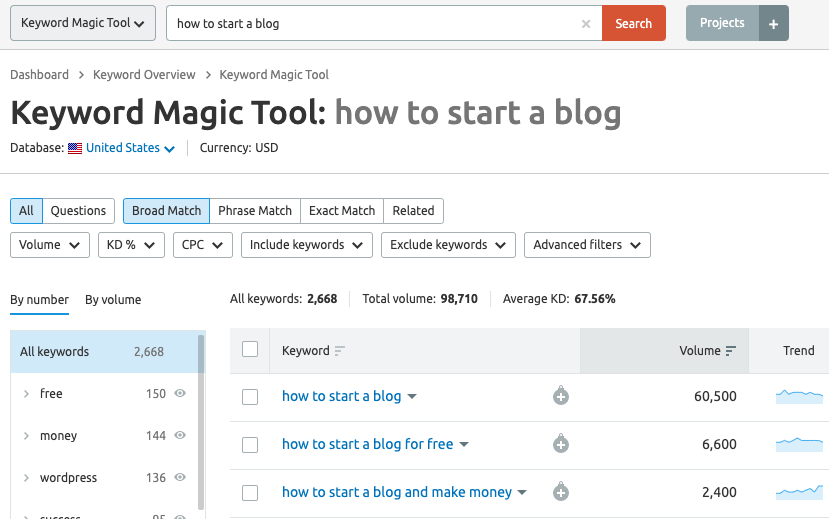
The higher the search volume, the higher the profit potential but also higher competition.
If you are still stuck on deciding which topic you will focus on, try the following:
2 Exercises to form a blogging topic
- Keep a journal to categorize recurring topics.
- Ask a friend for help.
More than likely, your loved ones or people whose opinion matters to you the most can help you form a blogging topic.
How much money can I make from blogging?
Making money from blogging is highly contingent on the number of variables.
The 3 factors to make money from blogging
- The number of users you send to your site.
- Price of the product/service you offer.
- Percentage of users that convert to customers. i.e., your conversion rate (CVR).
For example, 1,000 users come to your site with an average conversion rate of 2%.
20 users (1,000 x 2%) buy your product/service. Now let’s say your product/service is priced at $40.
In this scenario, you would have generated $800 in revenue. 20 users convert x $40 (price of product) = $800.
Conversion rates will vary depending on your industry, price point, and seasonality.
The industry benchmark, on average, is 2%. To increase your conversion rate, read my guide on how to write a blog post that converts.
How much money is needed to start a blog ?
You will need web hosting to start blogging. I have a partnership in place with Bluehost that provided me with a 50% discount for my audience. Regularly, the cost is $7.99, but you will only pay $3.95 per month with the discount.
I am sure you have heard of all the blogs that make a lot of money, which is why you are here to learn how to start a blog.
However, for your blog to make money, it will require time to increase your site traffic. Therefore producing quality content is the key.
According to Hubspot’s global research, 1-2 hours are spent writing a 500-word blog post on average.
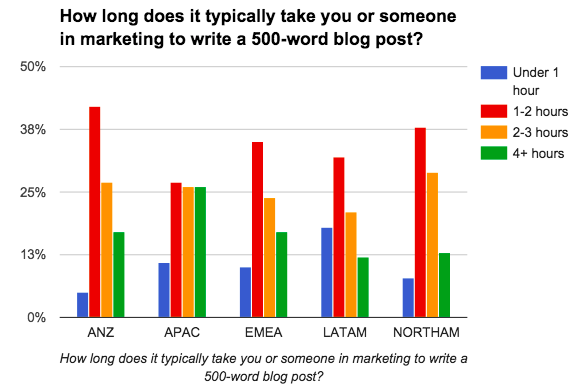
Don’t be discouraged by the information presented in the chart. If the barrier were lower, blogging would not be as profitable as it is. Let’s move on to step two now.
Step 2.) Choose a blogging platform
Don’t be overwhelmed by all the options to create a blog. All blogging platforms have strengths and weaknesses.
I highly recommend WordPress as a blogging platform. This guide will focus on creating a blog on WordPress.
If you would like to set up a blog on another platform, read my step-by-step guide about making a Wix website. You can easily set up a blog on a Wix website in 10 minutes or less.
Why is WordPress the most popular option for blogging?
WordPress is the top choice for blogging due to the scalability and flexibility it provides. Consider the following facts about WordPress.
- It’s free
- WYSIWYG editor (what you see is what you get)
- Self-hosted & Hosted options
- Massive inventory of plugins
What are the best blogging platforms to use?
Many blogging platforms exist, but the industry standard for blogging by far is WordPress.
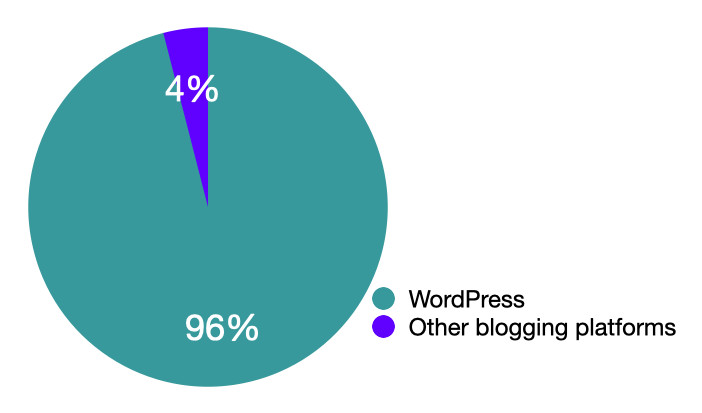
WordPress blogs represent 96% of the blogosphere, which is sizable. The numbers can’t be wrong. WordPress dominates due to the wide variety of plugins offered.
What is a WordPress Plugin?
A WordPress plugin is third party software from the WordPress community that can be installed on your blog.
Plugins extend the functionality of your site without any technical coding skills required.
Let’s touch on hosting, web hosting is required for any website/blog, but two options exist for hosting a WordPress blog. Self-hosted vs hosted.
What is the difference between self-hosted vs. hosted?
The differentiating factor is where the blog is hosted. The hosted option is usually free on most blog platforms. There will be drawbacks to choosing the hosted option.
When you are using a hosted option, the files are stored and hosted on the platform servers.
On the other hand, the self-hosted option is hosted on the server you choose from a web host provider.
This means you can select a faster server, which will help your site perform better.
WordPress.org vs. wordpress.com, I am sure you are wondering why the same company has two different domain name extensions (.org vs .com). wordpress.org is self-hosted, while wordpress.com is hosted.

How to start a blog on WordPress.org (Self-hosted option)
The self-hosted option (The most popular option) gives you the ability to have ownership over your domain name.
Therefore you will not have any limitations that you will encounter from the free option on wordpress.com (hosted-option). The vast majority of successful blogs are self-hosted.
How to start a blog on WordPress.com (Hosted option)
When you are new to the blogging world, the hosted option is the most enticing because it is technically free.
However, the technicality mentioned is due to restrictions that are applied when entirely free of charge.
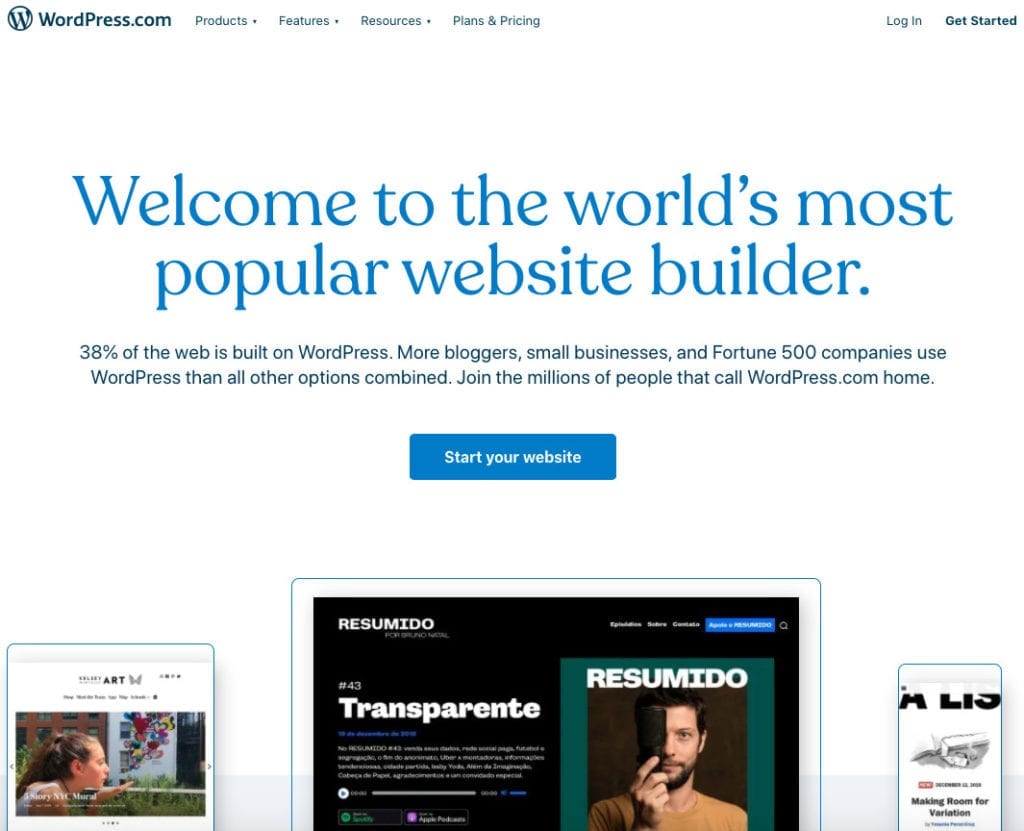
WordPress.com restrictions for free accounts
If you want to create a blog for free, WordPress.com will place ads on your site to make money on your free account.
You will not have control over these ads. WordPress.com also does not provide you with a personalized domain name for the free option.
For example, your domain will look like this: yoursite.wordpress.com. Similarly, you also have the opportunity to create a blog for free with Wix.com.
Feel free to read my comparison guide, WordPress vs. Wix. I break down the pros and cons of WordPress.org (Self-hosting) vs Wix.
Step 3.) Decide which web hosting provider to use
As stated, I have a partnership with Bluehost. While many other hosting providers have great unique features, Bluehost offers the best options for beginners by providing the following:
- Affordable pricing model
- Outstanding customer support
- One-click install of WordPress
- Money-back guarantee
- Reliability
After you have clicked “get started,” you should see four pricing options.
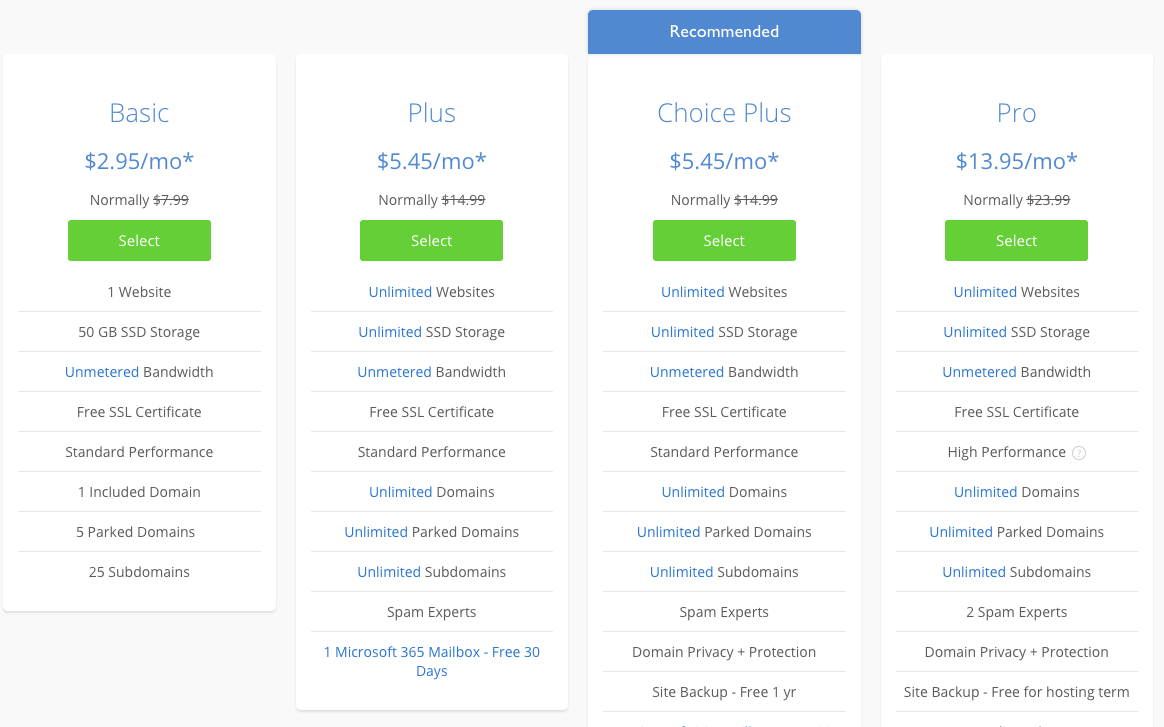
The lowest-priced option is ideal for getting up and running. Bluehost offers reliable scaling options as you grow.
When your site starts to gather more traffic, you will need to consider higher tiers.
Here is a break down of the traffic levels that differentiates the price points as growth occurs.
- Basic plan – Low level of traffic 5k or less in pageviews per month
- Plus plan – Medium level of traffic 25k and up in pageviews per month
- Choice Plus – High level of traffic 50k and up in pageviews per month
Step 4.) Pick a memorable domain name
If you take your time to buy a domain name, someone can and will register it, so don’t wait.
If you can’t find a domain name, Bluehost will give you the option of choosing a domain later but picking a domain sooner than later is highly advised.
Bluehost will throw in a free domain for a year. Additionally, if you have a pre-existing domain name, you can transfer it over.
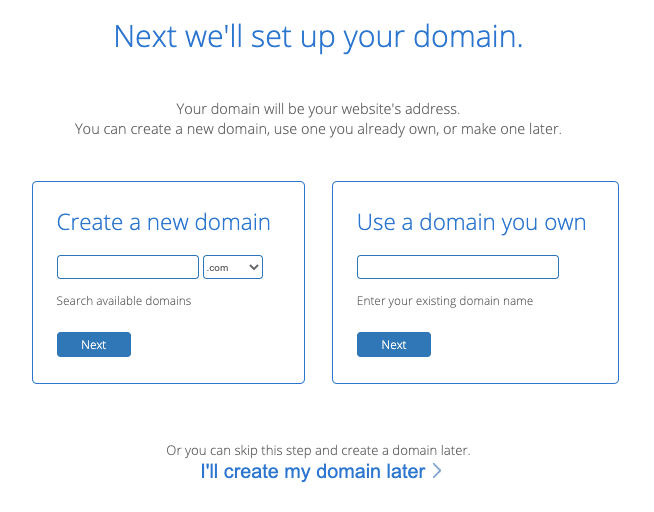
Your domain name is essential to establish your brand name. Branding differentiates you from the crowd.
Have you ever performed a Google search? What link did you click?
More than likely, a brand you know vs. one you don’t, right? Having a good domain name can help you with SEO (search engine optimization).
If you are not familiar with SEO, I will briefly touch on this later in the guide. Additionally, I wrote a guide on what is SEO and how it works that you should read once your site is live.
How does having a good domain help with SEO?
Having a brandable domain name can help increase your CTR (click-through-rate).
CTR is the percentage of people that click your domain to enter your site. CTR happens to be one of 200 ranking factors Google uses to help rank sites.
How to choose a good domain name
- Easy to spell
- Short vs. long.
- Catchy and easy to remember.
- Communicates your brand voice
- Use hyphens, not underscores
- Choose a .com address
- If a .com is not available choose .net or.co
You will begin the process of setting up a blog by creating an account with Bluehost. Bluehost will ask for the following information depicted below.
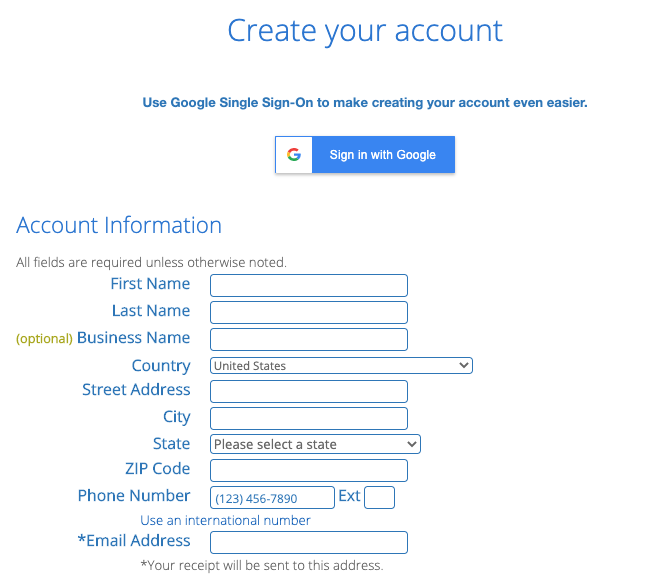
After you have completed the sign-up process, it is time to do the critical part of installing WordPress.
Getting set up on WordPress with Bluehost takes a click of a button with the one-click install feature.
Installing WordPress
Once you have your domain name and web hosting set up at this stage, you will see many icons in your Cpanel (Control panel). You only have to click the “Install WordPress” icon.
By clicking the icon, you will be setting up a blog on WordPress on Bluehost.
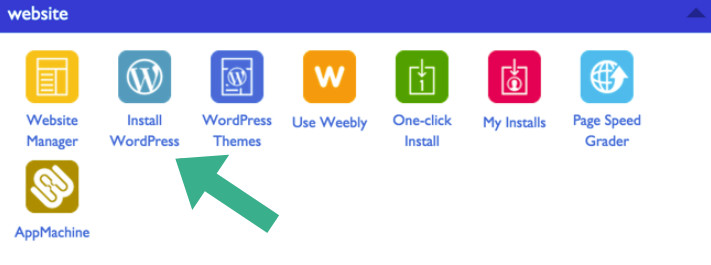
Next, let’s the most time-consuming step of starting your blog, selecting a design better known as choosing a theme.
Step 5.) Choose a blog theme
What are WordPress themes?
Themes are the aesthetics of your site. It is what people see from a design perspective. Before choosing a WordPress theme based on aesthetics, make sure to check the following boxes below.
How to pick a WordPress theme
- SEO friendly
- Fast loading
- Responsive design
- High ratings and reviews
- Easily customizable
I can’t express enough how many new bloggers fail to check the boxes listed above.
What usually happens is the prospective blogger decides to quit because they made a decision based on aesthetics vs. function.
The best advice I can offer you is not to spend a great deal of time looking at themes.
The most important thing to keep in mind is the functional design components of the theme you pick.
The key is to get started as soon as possible to create blog content to convert site traffic to make money.
Bluehost offers theme options, but I suggest you differentiate your blog with a theme that is not provided to the masses upon signing up.
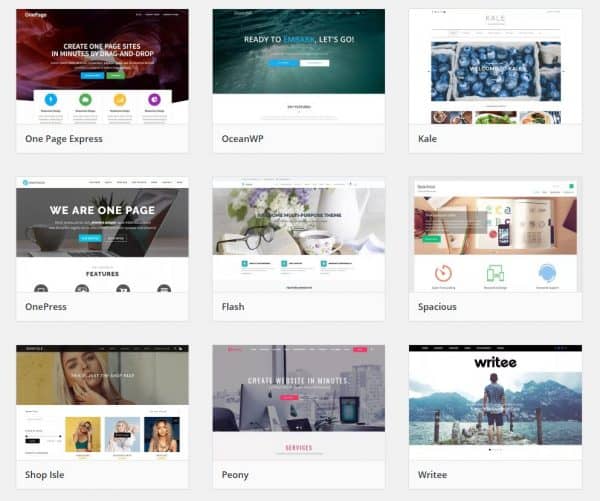
If you want unique, functional, and thoroughly vetted themes from professional theme developers, I recommend any theme from the following third-party vendors.
Recommended WordPress Themes
- StudioPress ( I use the authority pro theme )
- Elegant Themes (page builder included)
You can’t go wrong with any theme you select from the vendors I have vetted.
Pick one and get started today, don’t spend all your time on the Design. Remember, you can always change themes, and it is simple as a click of a button.
How to install a WordPress theme
At this point, you should have WordPress installed, and you have picked a theme you would like to install. Hopefully, you have chosen to go with a theme from one of my recommendations to save yourself time, money, and headaches.
Once you have chosen to purchase your theme, you will download your WordPress theme from a zip file.
What is a Zip file?
A computer file containing one or more files compressed for storage or transmission, often carrying the extension.ZIP.
Steps to install a WordPress theme
- Type in (yoursitename.com/admin)
- Login to the backend of WordPress
- Click “appearance“, then select Themes
- Select the “Upload”
- Find the zip file you downloaded
- Upload the theme from your zip file
- Hit “Activate“
Congratulations! You have now uploaded your pretty yet fully functional blog design.
At this point, you have set up your blog, but to make money from blogging, will require more action.
The next steps will dive into great detail on how to build traction for your blog.
Step 6.) Write great blog content
Without a shadow of a doubt, this part is the most important once you are up and running with WordPress. Starting a successful blog starts with being proactive in your approach towards creating content frequently.
Intent-based content writing
To be successful as a blogger, you must understand that people visit your site with specific intent.
For example, your purpose/intent for being here right now is to learn how to start a blog to make money.
You typed in a search term that ultimately directed you to this guide, and that was not by mistake.
It was planned; I focused on specific keywords to be addressed in this guide by conducting keyword analysis. Conducting keyword research is what drives results to make money from blogging.
Keyword analysis
I highly recommend using SEMrush to perform keyword analysis. Here is an example of what the tool will show you.
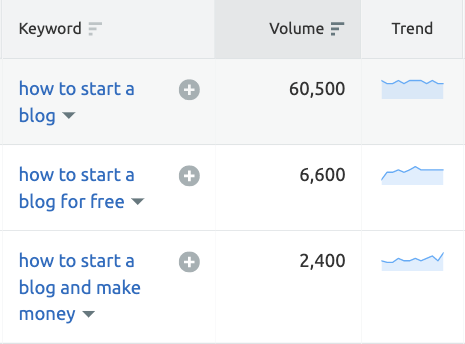
Performing keyword analysis is essential, but the vast majority of blogs exclude using the AIDA model in unison with keyword research.
The AIDA model is the secret sauce for a content strategy, and you can not produce great content without a content strategy.
Also you can’t fully scale a blog without a little help with writing your content. I recommend hiring a freelance writer to help you create content at scale.
Let’s touch on what the AIDA model is. But rest assured, once I explain what the AIDA model is, you will have a significant advantage over most bloggers who want to start a blog to make money.
The AIDA Model
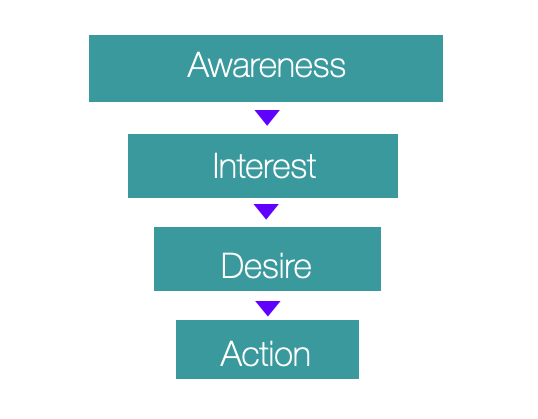
Each section in the Aida model is vital to start to make money from your blog.
AIDA marketing will separate those that will potentially make six figures or even potentially seven-figure incomes.
Let’s discuss each stage of the AIDA model in detail.
Awareness
Your audience enters search terms into Google to find answers. The hope is that they see you first, but how?
To find top of mind content that your users are typing in, ask Google to help you out.
Type in a specific keyword that pertains to your blog niche, then scroll to the bottom of the results and note the related search terms.
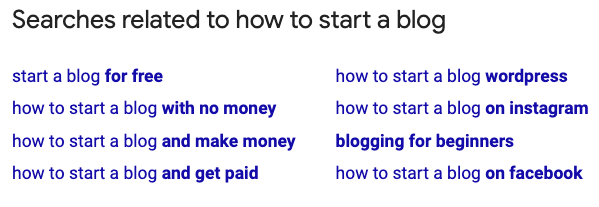
The goal here is to write content that your target audience is looking for. You have to position your content to be discovered.
I would not state anything that I don’t actively practice myself.
If you type in the query “How to start a blog” in Google, I gained a general directive to insert specific keywords in this guide.
I also quantified the search volume for those particular keywords by using SEMrush.
Interest
To gain insight into what people are interested in as it pertains to your niche, I recommend using the keyword gap analysis tool. Enter multiple competitor URLs to find the intersecting points of interest.
Once you identified those intersecting interests, create content to rank for keywords your competitors are not targeting currently.
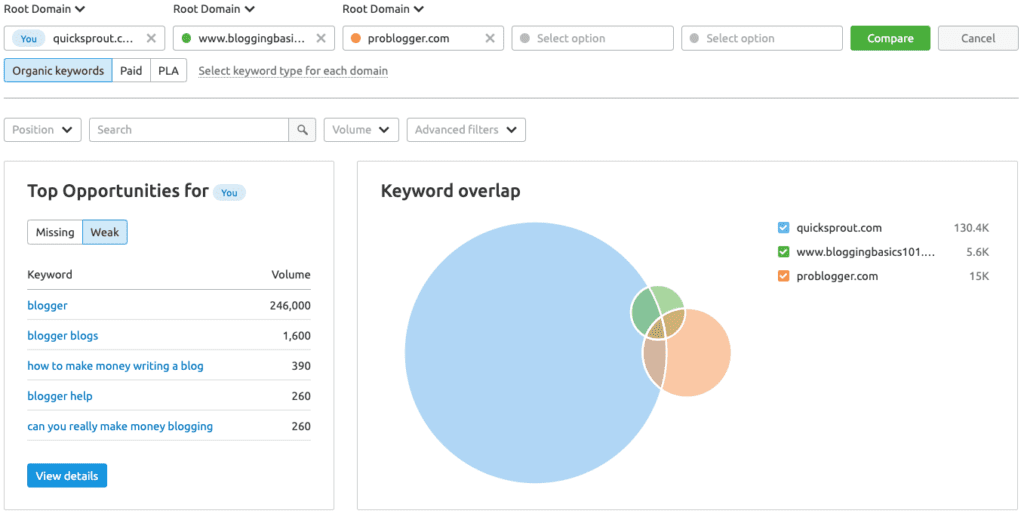
If you want to tap into your audience’s mind, SEMrush is a must-have tool to increase your traffic to your blog.
Another great tool to use to help you understand your site visitors’ interest is a tool called answer the public.
Answer the public –This free tool will show you a list of relevant topics you can write about by just entering a term.
I recommend using topics that include the target keywords identified from SEMrush and Google related search results.

Desire
Focus your attention on specific search terms that you know your audience needs.
The key to making money from blogging is understanding how to differentiate a want from a need.
–Darrell williams
Think about it. How many articles do you passively read per day? The articles you passively read are wants.
You want to be entertained, and you want to learn. Right? Now think about needs.
If you need something more than likely, you are acting on it and are not passively reading about it. You have a specific goal in mind.
Action
To focus on driving action, you have to be selective in the keywords you target. Keywords are not created equal.
What do I mean by keywords not being equal? Again think about the intent behind an entered search term.
Here is a secret most startups are aware of that most bloggers are not. There are three primary intent-based search queries.
The 3 intent-based search query types
- Informational keyword intent
- Commercial keyword intent
- Transactional keyword intent.
What is Informational keyword intent?
Informational queries are primarily focused on informed decision making. For example, look at the following query.
- Best [insert product/service] for …
Does your content answer the user’s specific intent to guide them towards an action?
What is commercial keyword intent?
If your users are informed, they more than likely start to enter this stage. Do the following queries below look familiar? Perhaps you entered similar search queries into a search engine before you made a purchase.
- [insert product/service ] reviews
- Compare [ insert product/service ]
People enter commercial keywords to make a purchase decision after gathering some initial information from the awareness stage.
What is Transactional keyword intent?
Transactional keywords are queries that are focused on making a purchase. Does the following look familiar?
- [insert product/service ] near me
- Affordable [product/service ]
A great way of identifying desire that can lead to action is listening to your audience.
How to listen to your audience
A great tool to use to listen to your audience is the Thrive Themes quiz builder plugin. This plugin is great for providing interactive quizzes that help you understand your audience.
You can build a quiz through a simple to use drag and drop interface.
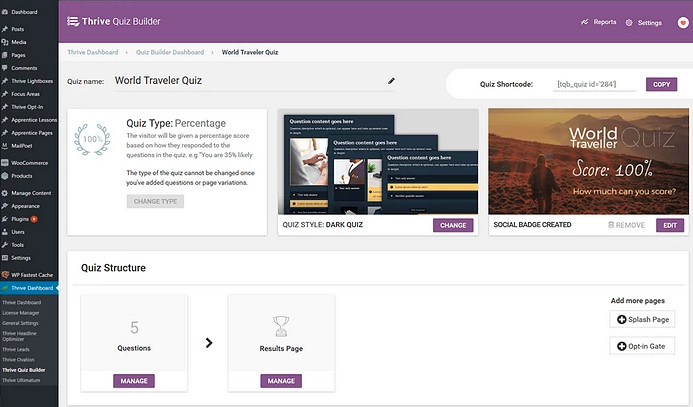
I also recommend using Quora.com to help you listen to your audience to understand certain pain points.
Gather an understanding of pain points and write content that addresses it.
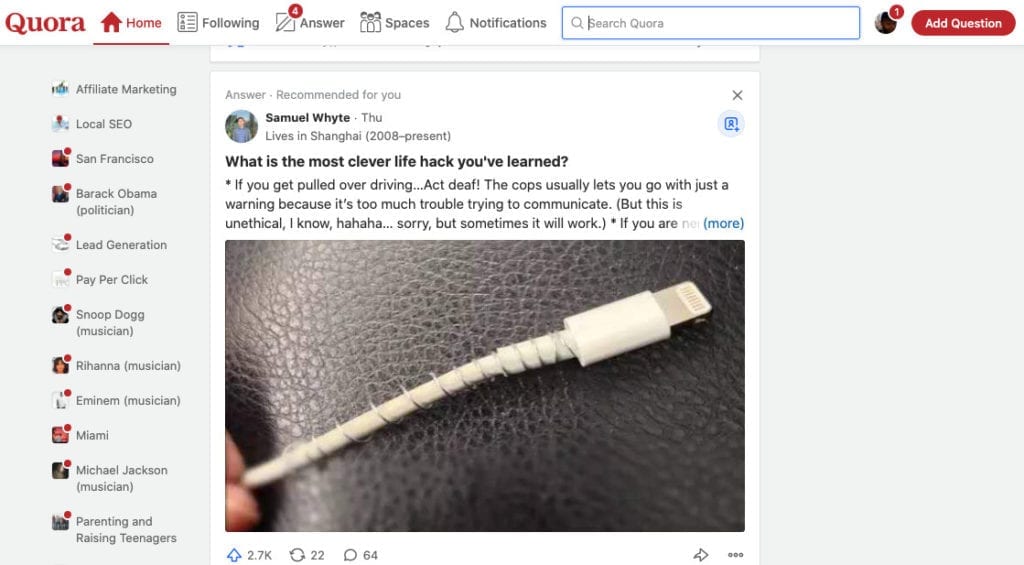
Growth hack tip #1:
Quora has millions of users; becoming an expert on a specific topic to send traffic to your site is a growth hack many startups use. This tactic is known as parasite SEO.
What is Parasite SEO ?
Parasite SEO, as the name implies, relies on a host. The host is the higher authority website.
A link is placed on the host that strategically funnels traffic from one website to another. The link placed on the host feeds off the influence and authority to gain popularity.
Don’t be spammy offer value, and don’t use every post as a means to send traffic to your site. Offer value, don’t become a spammer.
If you are not deploying the AIDA model and aligning intent-based keywords with keyword search volume, you do not have an effective content plan to get users to purchase.
Many bloggers charge a high fee to teach you the information I shared openly, but I gave you this information for free because I genuinely want to see you succeed 🙂
I have personally deployed this tactic for startups and established companies worth millions and even billions of dollars in valuation currently.
Let’s step back for a second. Starting any blog to make money starts with selling a specific service or product to funnel traffic to.
Let’s discuss a shortlist of blog monetization methods I put together if you don’t already have something in mind.
4 ways to make money from blogging
If you want to start earning money from a blog immediately, you should consider the following options.
- Consulting
- Selling products (Ecommerce)
- Affiliate programs
- Online Courses
Consulting
Making money from blogging starts with possessing a skill, no matter what it may be.
Consulting to earn immediate income from your blog is a highly viable option when you are a new blogger.
The beautiful part is you don’t need a lot of traffic to land a client. But of course, the more traffic you have, the more clients you may receive. Additionally, offering freelancing is a great option as well.
Selling products (ecommerce)
Selling products is an excellent way to generate money from your blog. If you are interested in creating an ecommerce presence. I wrote a step by step guide on setting up a Shopify store.
You can connect a WordPress blog to the Shopify platform easily. The beautiful part about blogging is it is one of the best ways to drive ecommerce sales. Cross-pollination exists with blogging and ecommerce.
Now is the perfect time to start selling products online. Since we are in a global pandemic due to the Covid-19 outbreak, look at the growth of the ecommerce industry.
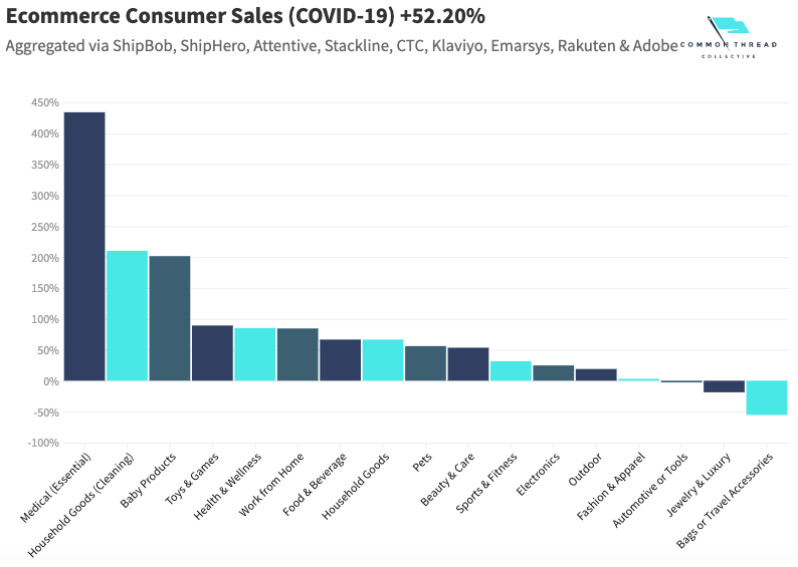
As you can see in the graph, the coronavirus impact on business is causing substantial growth in the ecommerce space. If you wanted to go this route, literally, there has never been a better time than now to create an ecommerce store.
Online Courses
If you have a specific skill, you can teach others for a profit. You can build up an audience on your blog to sell your courses directly.
I recommend if you choose to go this route that you look into using thinkific.com. Thinkific is one of the best online course platforms you can use.
Thinkific has drove 650 million + directly into blogger’s bank accounts.

Affiliate Marketing
What are affiliate programs?
Affiliate programs are partnerships between a merchant and a site owner. The merchant pays the site owner (the affiliate) to place trackable links on the site the affiliate owns.
The affiliate is compensated when a sale takes place on the merchant website due to the affiliate link.
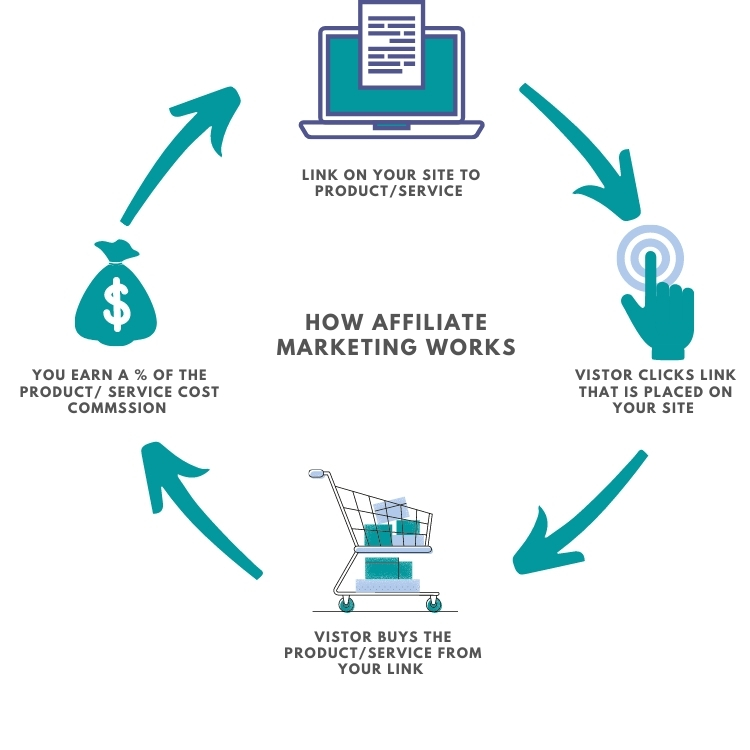
Affiliate programs help this site, and millions of other websites across the web earn money without ads disrupting the site experience.
The key to earning affiliate commissions is generating new content consistently and offering high value.
By generating content consistently, you can insert affiliate links into your posts for different affiliate programs.
By offering value, you will create repeat visitation to your site. Affiliate marketing is the best option for websites that are just starting and established blogs as well.
The importance of media
Keep in mind when you are creating content adding images are vital. When focusing on content writing, try to insert images that convey your message to your readers.
Growth hack tip #2:
Use Canva.com to create images. It is simple to use and has plenty of pre-made templates that are handpicked by world-class designers. I use this platform on this blog.
When you are adding media to your blog, keep in mind videos. Videos play a crucial role in non-written communication, which I advocate for using in your blog posts.
Now that I have covered the foundational elements of a content strategy at a high level, it is now time to address on-site SEO.
SEO may sound technically challenging, I assure you it is not.
If you would like to learn more about SEO, I recommend reading my guide on what is SEO and how it works.
Step 7.) Implement SEO
SEO (Search Engine Optimization) can be hard to wrap your head around being new to the blogging world. I have briefly touched on SEO throughout this guide.
I also touched on keyword research, which is part of the SEO Process. SEO is an extensive topic, but it is primarily formed from three pillars.
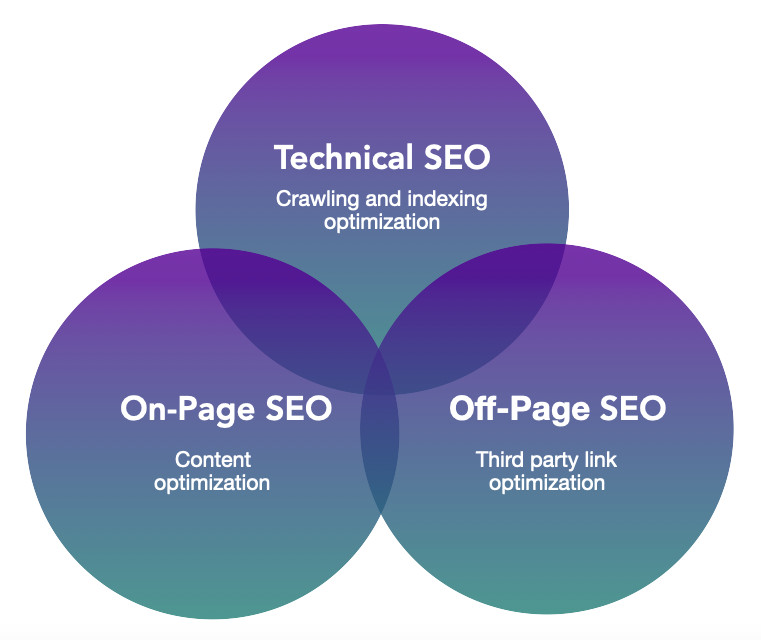
On-site SEO
The practice of optimizing site elements on a website (as opposed to links on external signals collectively known as “off-site SEO”) to improve search engine ranking and visibility.
Technical SEO
The process of optimization for search engines to crawl and index your site/blog. Technical SEO helps search engines crawl, access, and interpret specific information.
What is Indexing?
Indexing is the addition of your website to the S.E.R.P.S (search Engine Result Pages).
Search engine spiders crawl your site for relevant queries that correlate to what a user has entered as a query to populate indexed pages.
What is a Crawl?
A crawl is programmed robots/spiders to interpret content for specific keywords that people are typing into search engines.
Off-site SEO
The practice of positioning your posts/article links to be mentioned on external websites, better known as building links or link building.
To conduct link building, you will have to reach out to site owners to get your link placed on relevant external websites.
Growth hack tip #3:
By creating your own images, you can create backlinks to your site. If a website wants to use your image, they will have to mention your site by providing an image source credit.
A common problem from conducting link building outreach is finding an email address. For this reason, I created a tool that helps you identify site owner emails to reach out to.
Using this tool in unison with a tool called hunter.io will greatly help scale your outreach efforts.
Think of link building like a popularity contest. We all went to high school and knew what that was like, right? Link building is like high school. It is built on the principle of popularity contests.
Once the cool girl/guy states that you are cool too, then your set. When more prominent sites link to your site, you will receive more traffic. The more traffic you receive increases your ranking within Google.
Once you receive more of a higher rank in the search results, this gives you more credibility from what is known as DA (Domain Authority). Once you have credibility, this increases your CTR (click-through rate) on search results.
Simple concept, right? This process created a multibillion-dollar company that we all know as Google.
Google search Statistics
If you thought that was impressive, let’s break that down by per second.
And this is just an estimate at best since fluctuations occur during the holiday season and current events.
I showed you these stats to give you words of encouragement. There are literally billions of people looking for whatever you would like to offer them.
Google trends for SEO
Do you want to see what keyword fluctuations month over month or a year or longer? Check out Google trends. This is a beneficial tool to help you plan content around trending topics for SEO.
Configuring an SEO Plugin
Now that you know the main components of SEO, your primary focus should be on implementing on-site SEO for now.
While you may cringe and say to yourself, I am not an SEO expert. No problem, with the all in one SEO pack plugin, you can execute SEO optimizations for your site with ease.
How to install the all in one SEO pack on a WordPress site.
- Log in to your WordPress admin area.
- Navigate to the plugin section and click “Add new.”
- Enter “all in One SEO pack” in the search bar.
- Click “Install Now” select “Activate.”
Congratulations! you have installed the all in one SEO pack on your WordPress blog.
Here are a few more important aspects when setting up your site for SEO.
What is Google search console?
The Google Search Console is a tool to submit your site to the Google search results index. The search console also allows you to see which keywords drive users to your site.
It helps you to analyze your site’s clicks and ranking position. You will have to copy and paste a code to your website to be able to use it.
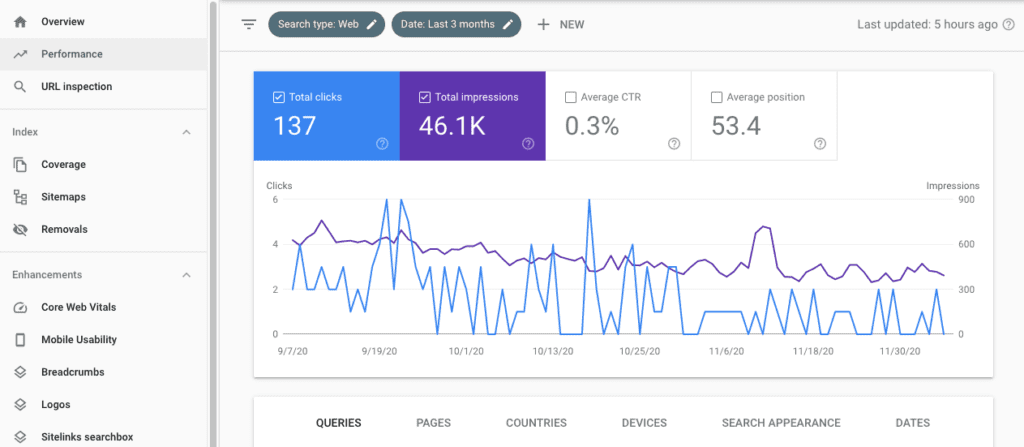
What is an XML sitemap?
An XML (Extensible Markup Language) is a virtual roadmap in the form of a file used to list all the URLs on a website. Sitemaps help identify search engines’ information and help crawl your site effectively to help index your site.
By using the all in one SEO pack you can easily create a sitemap with a few clicks of a button.
Growth Hack tip #4:
To see a website XML sitemap for any site type in the following into your browser sitename.com/sitemap.xml
What is a permalink?
Permalink stands for a permanent link, which means the link structure you setup will remain unchanged. Permalinks are intended to be easy for people and web crawls/ robots to read.
Here is a basic example of a permalink
http://websitename.com/blog/topic-of-post
Permalinks are essential to guide readers to the exact article they wanted to reference. You can think of it as a virtual bookmark. It is an extension of your domain name within specific articles you post.
Follow the instruction below to set up the recommended permalink structure highly regarded as the best SEO practice.
- Click “Settings” in WordPress select “Permalinks.”
- Select the “Post name” structure
- Save your settings
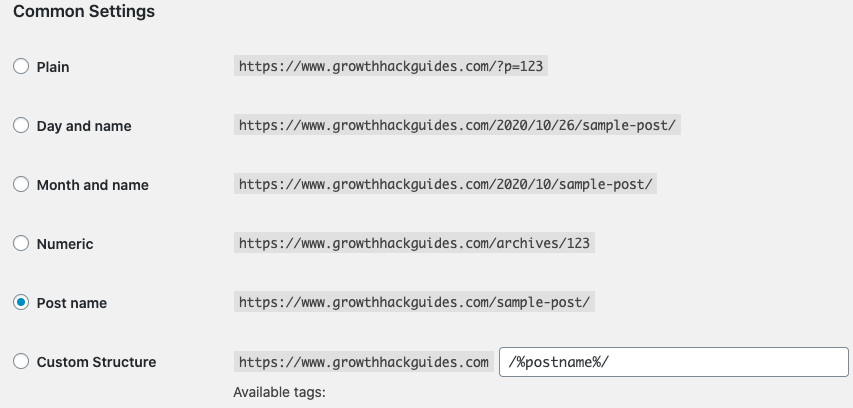
Great job! You have made it this far. Now it is time to understand who visits your website.
Step 8.) Install Google Analytics
Now it is time to add some power to your site. What is this power that I speak of? The power of knowledge, my friends 🙂 Analytics gives you insight into what takes place on your site. Without access to the analytics, you would not know what is going on.
Do you want to know if more women vs. men come to your site? Or how about knowing where your audience is specifically located geographically. These are questions analytics can help answer.
Here is an example of what Google analytics looks like once installed.
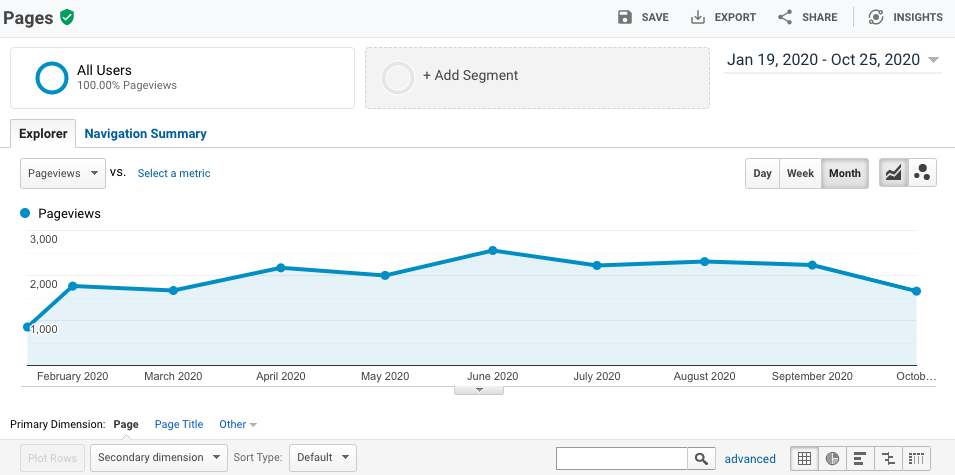
By using analytics, you can better tailor your marketing efforts towards those who are buying vs. those you assume are buying from you.
If you want this insight, all you have to do is install a plugin to do the hard lifting for you.
I recommend using monster insights, as this is the market leader for the quick installation of Google Analytics for WordPress sites. You don’t need to be a data scientist.
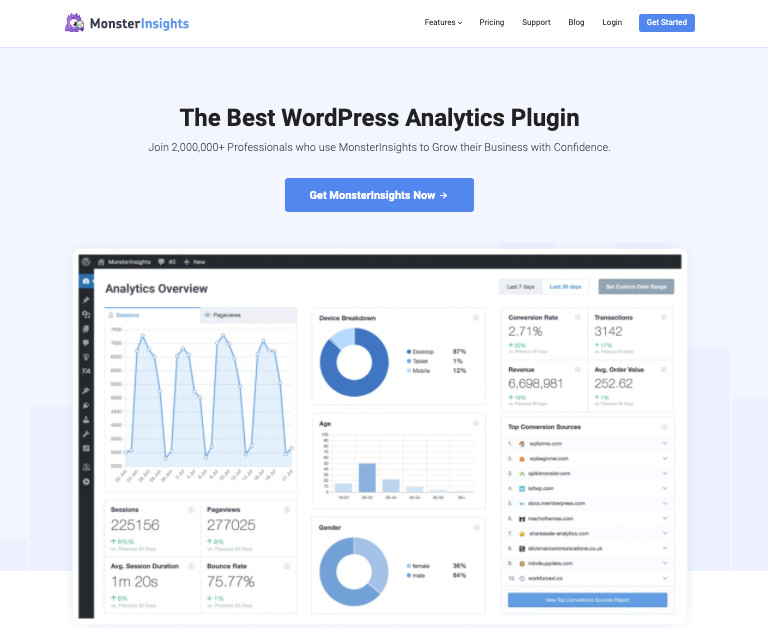
Implementing Google analytics with monster insights.
- Navigate to “Plugins” click”Add New.” Search for “Monster analytics.”
- Hit “install” once you have found the plugin.
- Click “Activate“
- “Authenticate with your Google account.”
- Accept the permissions from Google analytics.
- Complete the authentication.
Now you will be in the know about your site visitors. Congrats!
Step 9.) Promote your content across the web
Once you have analytics installed, you will be well equipped to understand which acquisition channels you should focus on.
As data starts to compile, I recommend consistently looking at your referrals tab in GA to see what is drives traffic and expand upon those sites and topics.
Here are a few traffic channels that can increase traffic to your blog that you will need to expand on.
Traffic channels to drive traffic to your blog
- Posting on social media
- Listing your business on directories
- Email marketing to your audience
- Guest blogging on authoritative sites
- Setting up a budget for Online ads
Social media
Social media is an extension of your site on external web platforms where you can share trending news items known as news feeds.
It is essentially the new age version of word of mouth marketing. The power comes from users sharing posts to get users to click over to your site.
Business directories
Directory listings can help you leverage high trafficked platforms to send traffic to your site, which is excellent.
Think of sites like Yelp.com. This is a perfect example of a business listing. Several business listings exist. You just have to find them.
Growth hack tip #5:
To find business listings as it pertains to your blogging topic copy and paste the following search operator into Google “Business listing” + ” Enter your blog topic”
Email marketing
Opt-in marketing, better known as email marketing, is excellent for sending users back to your site that has already visited your site.
Email marketing can also incentivize those same users to advocate for your site to have new users see your posts.
Guest blogging
Taking advantage of guest blogging is an excellent opportunity to place your expertise on high traffic websites to send users to your website.

Online ads
Running ads is self-explanatory but keep in mind that your traffic is contingent on your budget.
It is highly advised that you have a business model that is already profitable before investing heavily in paid ads. Also, online ads are not created equally.
Types of online ads
- PPC ( Pay Per Click)
- Display network ads ( Banner ads)
- Sponsored ads ( Pay Per Post )
- Social media ads
You will have to decide what is the best option for your blog. A golden rule of thumb is to pay attention to your ROAS and ROI.
What is ROAS?
Return On Advertising Spend (ROAS) measures the gross revenue generated for each dollar spent on advertising campaigns. ROAS identifies which methods are working and, more importantly, what you can do to improve your ad campaigns.
What is the difference between ROI and ROAS?
ROAS gauges the effectiveness of ads vs ROI that estimates the profitability of ads.
How do you calculate ROI?
ROI is calculated by dividing profit by the original capital cost of investment multiplied by 100.
Here is the calculation of ROI represented as a formula.
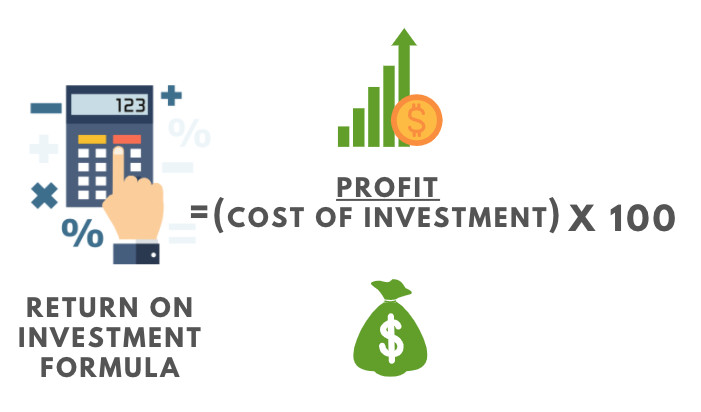
How do you calculate ROAS?
ROAS is calculated by dividing revenue from ads by the original capital cost of ads multiplied by 100.
Here is the calculation of ROAS represented as a formula.
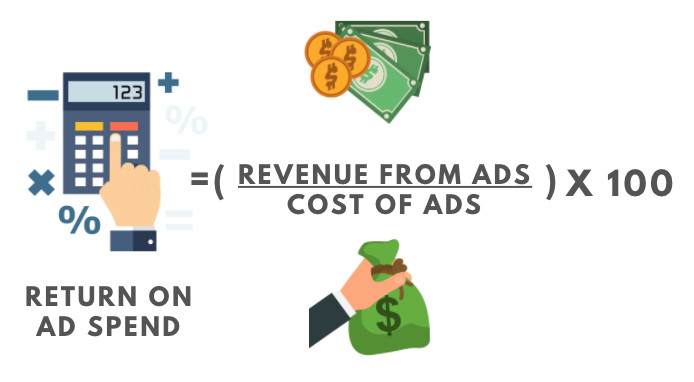
Step 10.) Build retention offering value to readers
Offering value is the secret to how to start a blog that makes money. What does your audience want before you begin offering services?
Listen first and foremost, and keep in contact with your audience. Seth Godin, talks at length about offering value. Seth mentions in his book Tribes the following quote.
A tribe is a group of people that are connected. Tribes are connected to a leader and connected to an idea.” – Seth Godin
If you listen and service your audience accordingly, they will come back to you. Additionally, they will spread the word about you.
How to build retention to your blog
- Write for the reader first and foremost
- Have a clear message and value proposition
- Setup an email opt-in incentive to keep in touch
- Leverage social proof
How to start a Blog FAQ’s
How to start a blog for free and make money?
You can start a blog for free on wix.com, Tumblr, and blogger. Keep in mind that you will have certain restrictions for using a free service.
How much can I expect to make from blogging?
How much you can potentially make is highly contingent on the following four primary factors.
- How many times per day, per week per month, do you post?
- Are you active with the promotion of your posts?
- What monetization methods are you using in your posts?
- Do you have a good, bad, average, or high conversion rate?
What do I do if a domain name I want is taken?
If the domain you would like to have is registered, here is what you can do:
- Try another variation of the domain name you would like to purchase.
- Look into utilizing another domain extension if .com is not available.
- Buy a premium domain that is up for sale in an auction.
Here are a few domain name auctions where you can find some domains.
Why do most blogs fail?
The truth is most bloggers that set out solely to make money fail. Why? Because of the following reasons that you should avoid.
- Intermittent blogging practices e.g Post made once per month
- Low quality of content
- Over-optimization e.g To many ads
- Lack of Empathy with your audience (Place yourself in their shoes)
- Little to no engagement with your core audience (Respond to comments)
- No interesting facts or statistics provided (Shareability is key)
- The topic for your blog does is not broad enough to be monetized.
- SEO is never really addressed
- Analytics insights are not leveraged
- Building low-quality backlinks
- Retention is not built into content (Email lists)
Here is an infographic on the ten steps to start a blog and make money to recap. Please feel free to share the infographic.
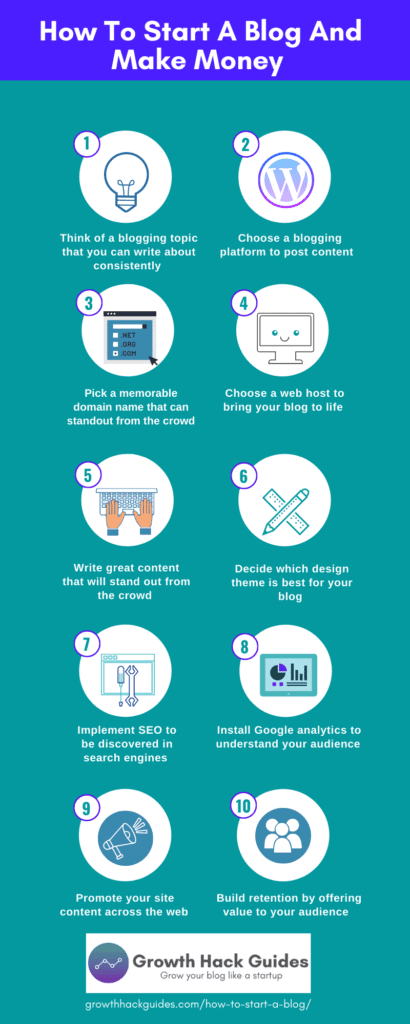
Share this Image On Your Site
Please keep me informed and drop some comments below and let me know the most challenging part of starting a blog.

Leave a Reply